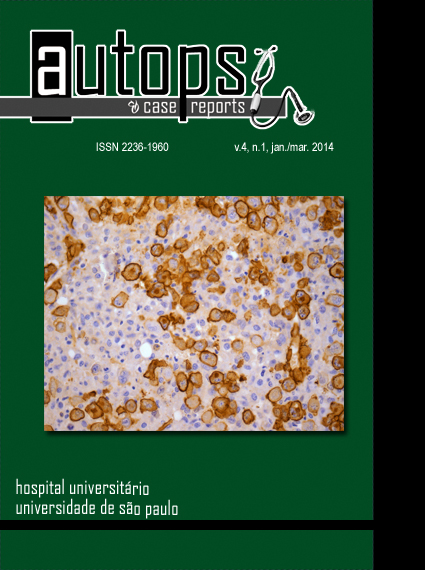Adult-onset opsoclonus-myoclonus-ataxia syndrome as a manifestation of brazilian lyme disease-like syndrome: a case report and review of literature
DOI:
https://doi.org/10.4322/acr.%25y.81208Keywords:
Opsoclonus-Myoclonus Syndrome, Lyme Neuroborreliosis, Borrelia burgdorferi.Abstract
Described in 1962, the opsoclonus-myoclonus-ataxia syndrome (OMAS) is a rare, neurologically debilitating disorder with distinct characteristics that may begin in childhood or adult life. Although many cases remain without etiological diagnosis, others are related to neoplasms and infectious diseases. We report a 41-year-old previously healthy male with an 8-day history of headache, vertigo, nausea, vomiting, and nystagmus. After a normal brain computed tomography and lymphocytic pleocytosis in cerebral spinal fluid (CSF), intravenous acyclovir therapy was initiated in the emergency room. On the third day of hospitalization, the diagnosis of OMAS was made based on the presence of chaotic and irregular eye movements, dysarthric speech, gait instability, generalized tremor, and myoclonic jerks. In the face of his neurological worsening, ampicillin followed by nonspecific immunotherapy (methylprednisolone and intravenous immunoglobulin) was prescribed, with mild clinical improvement. After a thorough laboratory workup, the definite diagnosis of neuroborreliosis was established and ceftriaxone (4 g/daily/3wks) and doxycycline (200 mg/day/2 mo) was administered. Toward the end of the ceftriaxone regimen, the neurologic signs substantially improved. We believe this to be the first case description of OMAS as clinical presentation of Brazilian Lyme disease-like syndrome (Baggio-Yoshinari syndrome).Downloads
Download data is not yet available.
Downloads
Published
2014-03-31
Issue
Section
Article / Clinical Case Report
License
Copyright
Authors of articles published by Autopsy and Case Report retain the copyright of their work without restrictions, licensing it under the Creative Commons Attribution License - CC-BY, which allows articles to be re-used and re-distributed without restriction, as long as the original work is correctly cited.
How to Cite
Lino, A. M. M., Spera, R. R., Campos, F. P. F. de, Freitas, C. H. de A., Garcia, M. R. T., Lopes, L. da C., & Prokopowitsch, A. S. (2014). Adult-onset opsoclonus-myoclonus-ataxia syndrome as a manifestation of brazilian lyme disease-like syndrome: a case report and review of literature. Autopsy and Case Reports, 4(1), 29-37. https://doi.org/10.4322/acr.%y.81208



